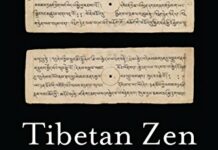
Ebook Info
- Published: 2019
- Number of pages: 272 pages
- Format: PDF
- File Size: 1.25 MB
- Authors: Sam van Schaik
Description
An engaging introduction to Zen Buddhism, featuring a new English translation of one of the earliest Zen texts Leading Buddhist scholar Sam van Schaik explores the history and essence of Zen, based on a new translation of one of the earliest surviving collections of teachings by Zen masters. These teachings, titled The Masters and Students of the Lanka, were discovered in a sealed cave on the old Silk Road, in modern Gansu, China, in the early twentieth century. All more than a thousand years old, the manuscripts have sometimes been called the Buddhist Dead Sea Scrolls, and their translation has opened a new window onto the history of Buddhism. Both accessible and illuminating, this book explores the continuities between the ways in which Zen was practiced in ancient times, and how it is practiced today in East Asian countries such as Japan, China, Korea, and Vietnam, as well as in the emerging Western Zen tradition.
User’s Reviews
Reviews from Amazon users which were colected at the time this book was published on the website:
⭐I really like Sam van Schaik’s other books and this latest on the roots of the Chinese Zen tradition is also excellent. As both an expounder and translator of Buddhism, van Schaik is very clear and eloquent, yet very simple and down to earth.This book begins with a wonderful 81 page section on the history of Zen (both ancient in Asia and modern in America), as well as an explanation of its essential principles and practices. Then part II, the bulk of the book, is the translation (from both Chinese and Tibetan versions) of the first chronicle of the history of Zen as found in “Masters of the Lanka” a 7th century text found sealed in a cave in Dunhuang China since the 11th century by early 20th century explorers. This text is in seven chapters which deal sequentially with the first seven teachers of the Zen approach (beginning with the 5th century Indian monk Gunabhadra). Each chapter has a several page intro by van Schaik and then the translation. At the end are extensive chapter notes and bibliographic references.What is interesting about the Masters of the Lanka is what it says about the practice of Zen when it first began. As an early record it also lacks the kind of hagiographic approach which the more recent accounts often take. To give a taste of both van Schaik’s translating style and the ancient zen material I quote here from the preface to the main text where the 7th century compiler (Jingjue) gives a succinct overview of the Buddhist path.”If we look closely at samsara, we can see that it is nothing more than repeated acts of grasping. When one contemplates the mind that grasps, it is originally pure mind. In truth, mind does not exist. In this state of stillness there is no deluded thought. Where there is movement there is always stillness. Where there is stillness there is no striving.”Where there is thought, there is always thusness. In thusness there are no afflictions or attachment. The absence of afflictions is purity. The absence of attachment is liberation. The afflictions are the cause of samsara, and purity is the result of awakening. The most profound teachings are actually empty. The end of the path is beyond language; language is contrary to the ultimate.”Even if one considers the source in terms of emptiness of intrinsic nature, it is not a source that can be named. Emptiness itself is beyond language, and the mind cannot go there…”The nature of the path is empty yet boundless, liberating, vast, clear and subtle. It brings the entire universe to stillness. It pervades ancient and modern, yet is always pure by nature. It encompasses the highest and the lowest, is ever-present and pure. It is the pure buddha realm.”Know this – within a single hair there is the entire universe, and one mote of dust contains the limitless cosmos. These statements are true! Now, go and sit in meditation and verify them for yourself, rather than depend on what is expounded in the three vehicles.” (p.98-99)Overall this is a wonderfully readable and educational book about Zen’s beginning as well as a clear presentation on the essential spirit of the Zen approach. Highly recommended!
⭐I found this to be a wonderful book on Zen Buddhism. It’s an easy but very informative read on how Zen Buddhism got started and who the key figures were. It also goes over a text that I had never head of before—the Masters of the Lanka–which was discovered in an old cave in China in the early part of the 20th century. The Masters of the Lanka is over 1,000 years old and contains some priceless wisdom from old Zen masters. (Some I had never heard of.) I highly recommend this book!
⭐Excellent historical review of Zen practice throughout the ages. Well done. Easy to read.
⭐Recommends it for: anyone who has interest and little information in buddhism and zen.
⭐This is a very good book.
Keywords
Free Download The Spirit of Zen (The Spirit of …) in PDF format
The Spirit of Zen (The Spirit of …) PDF Free Download
Download The Spirit of Zen (The Spirit of …) 2019 PDF Free
The Spirit of Zen (The Spirit of …) 2019 PDF Free Download
Download The Spirit of Zen (The Spirit of …) PDF
Free Download Ebook The Spirit of Zen (The Spirit of …)

